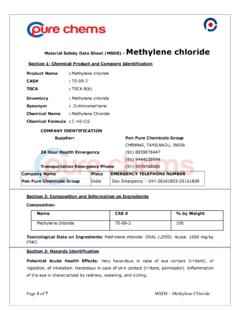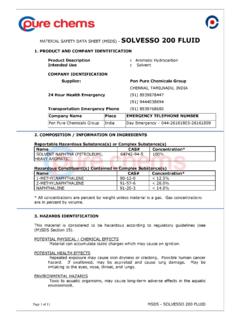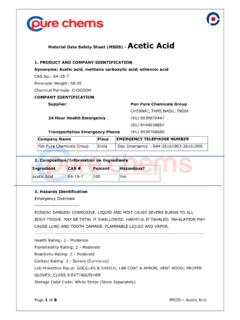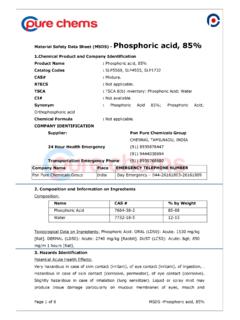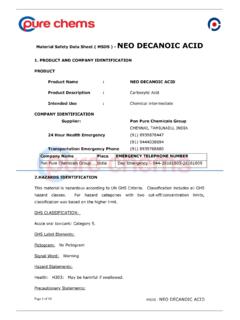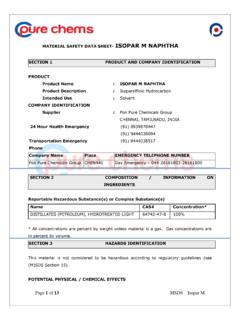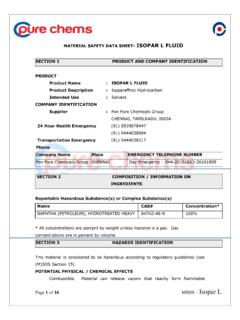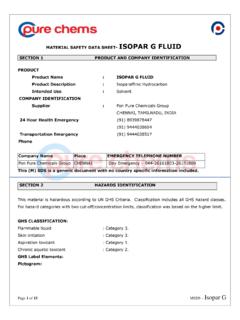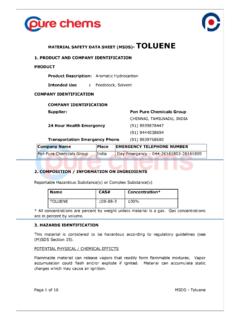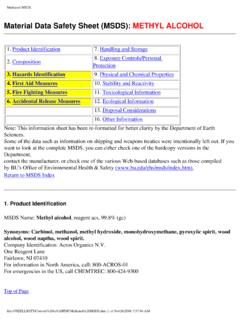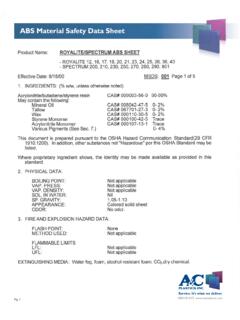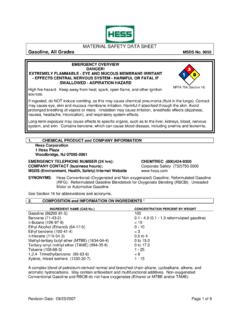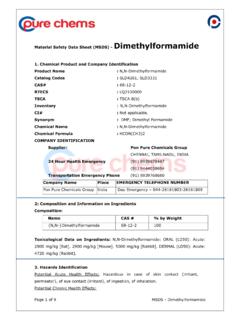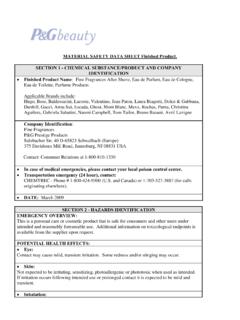Transcription of MATERIAL SAFETY DATA SHEET- ( MSDS ) METHYL ETHYL …
1 msds : MEK Page 1 of 15 MATERIAL SAFETY data sheet - ( msds ) METHYL ETHYL KETONE 1. PRODUCT AND COMPANY IDENTIFICATION PRODUCT Product Name : METHYL ETHYL KETONE Product Description : Ketone Intended Use : Solvent COMPANY IDENTIFICATION Supplier: Pon Pure Chemicals Group CHENNAI, TAMILNADU, INDIA 24 Hour Health Emergency (91) 8939878447 (91) 9444038694 Transportation Emergency Phone (91) 8939768680 Company Name Place EMERGENCY TELEPHONE NUMBER Pon Pure Chemicals Group India Day Emergency 044-26161803-26161809 2 .COMPOSITION / INFORMATION ON INGREDIENTS Reportable Hazardous Substance(s) or Complex Substance(s) Name CAS# Concentration* METHYL ETHYL KETONE 78-93-3 100% * All concentrations are percent by weight unless MATERIAL is a gas.
2 Gas concentrations are in percent by volume. 3. HAZARDS IDENTIFICATION This MATERIAL is considered to be hazardous according to regulatory guidelines (see msds Section 15). POTENTIAL PHYSICAL / CHEMICAL EFFECTS Flammable. MATERIAL can release vapors that readily form flammable mixtures. msds : MEK Page 2 of 15 Vapor accumulation could flash and/or explode if ignited. POTENTIAL HEALTH EFFECTS Irritating to eyes. If swallowed, may be aspirated and cause lung damage. May cause central nervous system depression. Target Organs: Eye | NFPA Hazard ID: Health: 2 Flammability: 3 Reactivity: 0 HMIS Hazard ID: Health: 1 Flammability: 3 Reactivity: 0 NOTE: This MATERIAL should not be used for any other purpose than the intended use in Section 1 without expert advice.
3 Health studies have shown that chemical exposure may cause potential human health risks which may vary from person to person. 4. FIRST AID MEASURES INHALATION Remove from further exposure. For those providing assistance, avoid exposure to yourself or others. Use adequate respiratory protection. If respiratory irritation, dizziness, nausea, or unconsciousness occurs, seek immediate medical assistance. If breathing has stopped, assist ventilation with a mechanical device or use mouth-to-mouth resuscitation. SKIN CONTACT Wash contact areas with soap and water. Remove contaminated clothing. Launder contaminated clothing before reuse. EYE CONTACT Flush thoroughly with water for at least 15 minutes. Get medical assistance. INGESTION Seek immediate medical attention.
4 Do not induce vomiting. NOTE TO PHYSICIAN If ingested, MATERIAL may be aspirated into the lungs and cause chemical pneumonitis. Treat appropriately. 5. FIRE FIGHTING MEASURES EXTINGUISHING MEDIA msds : MEK Page 3 of 15 Appropriate Extinguishing Media: Use water fog, foam, dry chemical or carbon dioxide (CO2) to extinguish flames. Inappropriate Extinguishing Media: Straight Streams of Water FIRE FIGHTING Fire Fighting Instructions: Evacuate area. If a leak or spill has not ignited, use water spray to disperse the vapors and to protect personnel attempting to stop a leak. Prevent runoff from fire control or dilution from entering streams, sewers, or drinking water supply. Firefighters should use standard protective equipment and in enclosed spaces, self-contained breathing apparatus (SCBA).
5 Use water spray to cool fire exposed surfaces and to protect personnel. Unusual Fire Hazards: Highly flammable. Vapors are flammable and heavier than air. Vapors may travel across the ground and reach remote ignition sources causing a flashback fire danger. Hazardous MATERIAL , Firefighters should consider protective equipment indicated in Section 8. Hazardous Combustion Products: Smoke, Fume, Incomplete combustion products, Oxides of carbon FLAMMABILITY PROPERTIES Flash Point [Method] : -4C (25F) [ ASTM D-56] Flammable Limits (Approximate volume % in air): LEL: UEL: Autoignition Temperature : >450 C (842 F) 6. ACCIDENTAL RELEASE MEASURES NOTIFICATION PROCEDURES In the event of a spill or accidental release, notify relevant authorities in accordance with all applicable regulations.
6 US regulations require reporting releases of this MATERIAL to the environment which exceed the applicable reportable quantity or oil spills which could reach any waterway including intermittent dry creeks. The National Response Center can be reached at (800)424-8802. PROTECTIVE MEASURES Avoid contact with spilled MATERIAL . Warn or evacuate occupants in surrounding and msds : MEK Page 4 of 15 downwind areas if required due to toxicity or flammability of the MATERIAL . See Section 5 for firefighting information. See the Hazard Identification Section for Significant Hazards. See Section 4 for First Aid Advice. See Section 8 for Personal Protective Equipment. SPILL MANAGEMENT Land Spill: Eliminate all ignition sources (no smoking, flares, sparks or flames in immediate area).
7 Stop leak if you can do it without risk. All equipment used when handling the product must be grounded. Do not touch or walk through spilled MATERIAL . Prevent entry into waterways, sewer, basements or confined areas. A vapor suppressing foam may be used to reduce vapors. Absorb or cover with dry earth, sand or other non-combustible MATERIAL and transfer to containers. Large Spills: Use clean non-sparking tools to collect absorbed MATERIAL . Large Spills: Water spray may reduce vapor; but may not prevent ignition in closed spaces. Recover by pumping or with suitable absorbent. Water Spill: Stop leak if you can do it without risk. Eliminate sources of ignition. Warn other shipping. Seek the advice of a specialist before using dispersants.
8 Water spill and land spill recommendations are based on the most likely spill scenario for this MATERIAL ; however, geographic conditions, wind, temperature, (and in the case of a water spill) wave and current direction and speed may greatly influence the appropriate action to be taken. For this reason, local experts should be consulted. Note: Local regulations may prescribe or limit action to be taken. ENVIRONMENTAL PRECAUTIONS Large Spills: Dike far ahead of liquid spill for later recovery and disposal. Prevent entry into waterways, sewers, basements or confined areas. 7. HANDLING AND STORAGE HANDLING Avoid contact with skin. Avoid contact with eyes. Prevent exposure to ignition sources, for example use non-sparking tools and explosion-proof equipment.
9 Potentially toxic/irritating fumes/vapors may be evolved from heated or agitated MATERIAL . Use only with adequate ventilation. Do not enter storage areas or msds : MEK Page 5 of 15 confined spaces unless adequately ventilated. Use proper bonding and/or ground procedures. However, bonding and grounds may not eliminate the hazard from static accumulation. Prevent small spills and leakage to avoid slip hazard. Loading/Unloading Temperature: [Ambient] Transport Temperature: [Ambient] Transport Pressure: [Ambient] Static Accumulator: This MATERIAL is not a static accumulator. STORAGE Ample fire water supply should be available. A fixed sprinkler/deluge system is recommended. Keep container closed. Handle containers with care.
10 Open slowly in order to control possible pressure release. Store in a cool, well-ventilated area. Outside or detached storage preferred. Storage containers should be grounded and bonded. Fixed storage containers, transfer containers and associated equipment should be grounded and bonded to prevent accumulation of static charge. Storage Temperature : [Ambient] Storage Pressure : [Ambient] Suitable Containers/Packing : Tank Trucks; Drums; Barges; Tank Cars Suitable Materials and Coatings (Chemical Compatibility): Carbon Steel; Stainless Steel; Polyester; Teflon; Butyl Rubber Unsuitable Materials and Coatings : Ethylene-proplyene-diene monomer (EPDM); Polyacrylonitrile; Polypropylene; Polystyrene; Polyvinyl Alcohol; PVC; Polyethylene; Natural Rubber 8.
